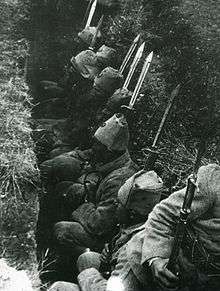Mehmetçik

Mehmetçiks in trench, waiting for the order to attack with fixing the bayonet on their rifles during the artillery preparatory fires (Turkish War of Independence).
Mehmetçik (literally: Little Mehmet) is a general term used affectionately to refer soldiers of the Ottoman Army and Turkish Army. It is similar to the colloquialisms Tommy Atkins, Doughboy, and Digger used for the British, U.S., and Austrialian armies.[1][2] Although it is used for especially infantryman (foot soldier),[3] terms such like Piyade Mehmetçik (Infantryman Little Mehmet) and Süvari Mehmetçik (Cavalryman Little Mehmet), Topçu Mehmetçik (Artilleryman Little Mehmet) have occasionally been seen.[4]
It is considered that "Mehmetçik" was coined after Ottoman Army Sergeant Bigalı Mehmet Çavuş (1878–1964), who fought during the Gallipoli Campaign of World War I.[5][6][7][8]
See also
References
- ↑ David Nicole, (Illustrated by Christa Hook), Ottoman Infantryman 1914–18, Osprey Publishing, 2010, ISBN 978-1-84603-506-7, p. 38.
- ↑ Phil Taylor, Pam Cupper, Gallipoli, A Battlefield Guide, Kangaroo Press, 1989,
- ↑ Şehnaz Tahir Gürçağlar, The politics and poetics of translation in Turkey, 1923–1960, Rodopi, 2008, p. 262.
- ↑ For example in Arif Bilge, Anadolunun Türkleşmesi, İslâmlaşması ve aramızdaki Rumlar Tarihi, Ülkü Basımevi, 1971.
- ↑ Tarı Güner, Safiye (2017-02-04). "Bigalı Mehmet Çavuş mezarı başında anıldı". Hürriyet (in Turkish). Retrieved 2017-10-05.
- ↑ "Mehmetçik'in isim babasına anıt mezar". Çanakkale Olay (in Turkish). 2017-05-22. Retrieved 2017-10-05.
- ↑ Tarı Güner, Safiye (2017-01-19). "İlker Başbuğ, Bigalı Mehmet Çavuş'un mezarını ziyaret etti". Hürriyet (in Turkish). Retrieved 2017-10-05.
- ↑ David Nicole, (Illustrated by Christa Hook), Ottoman Infantryman 1914-18, Osprey Publishing, 2010, ISBN 978-1-84603-506-7, p. 38.
This article is issued from
Wikipedia.
The text is licensed under Creative Commons - Attribution - Sharealike.
Additional terms may apply for the media files.